#Ted McCarty
Text
Are we about to see a new Gibson Theodore model?
If you have watched the recent Gibson Amplifier announcement, then chances are you would have seen the accompanying promo video. A video that appears to tease a new US Gibson Theodore model.
Are we about to see a new Gibson Theodore model?
During the official promo video for the new Gibson Falcon amp models, a Theodore model can be seen being played around the 13.45-minute mark.
Are we about to…

View On WordPress
#Falcon 20#Falcon 5#Gibson#Gibson Custom Shop#Gibson Theodore#Guitar#Paul Reed Smith#PRS#Ted McCarty#Theodore#Theodore McCarty#USA#video#YouTube
0 notes
Photo

I just realized that we’ve not had anything lately for you denizens of the #lowend . So for #gibsunday here’s a 1954 Gibson EB-1 Electric Bass! It comes with its original pink-lined hard shell case and its adjustable end pin extension for stand-up playing. Link in our profile. - This is a really nice original example of the instrument we think this is just about the coolest and most distinctive electric bass ever designed -- and one of the most eccentric! The "Gibson Electric Bass" (The name EB-1 was not used until 1958, when the semi-hollow EB-2 debuted) was first issued in mid-1953 as one of the earliest solid-body basses. The "fiddle-shaped" body design is unique and owes nothing but general concept to the slightly earlier (late 1951-52) Fender Precision -- and was likely an inspiration to Hofner in Germany! Gibson president Ted McCarty wanted something that was as different from the Fender Bass as possible, and that's what the company engineers delivered. - - - - - #retrofretvintageguitars #vintagegibson #gibsoneb1 #electricbass #electricbassguitar #gibsonsofinstagram #gibsonbass #bassforsale #bassguitar #bassplayersunited #bassgram #basslove #bassplayermagazine #instabass #bassist #bassplayer #bassguitarist #electricbassist ##bassesofinstagram #eb1 #madeinkalamazoo #lowendbasses (at Retrofret Vintage Guitars) https://www.instagram.com/p/CnKa0vPu8SR/?igshid=NGJjMDIxMWI=
#lowend#gibsunday#retrofretvintageguitars#vintagegibson#gibsoneb1#electricbass#electricbassguitar#gibsonsofinstagram#gibsonbass#bassforsale#bassguitar#bassplayersunited#bassgram#basslove#bassplayermagazine#instabass#bassist#bassplayer#bassguitarist#electricbassist#bassesofinstagram#eb1#madeinkalamazoo#lowendbasses
38 notes
·
View notes
Photo


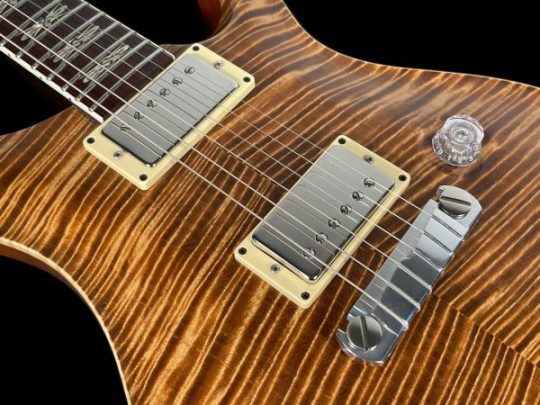





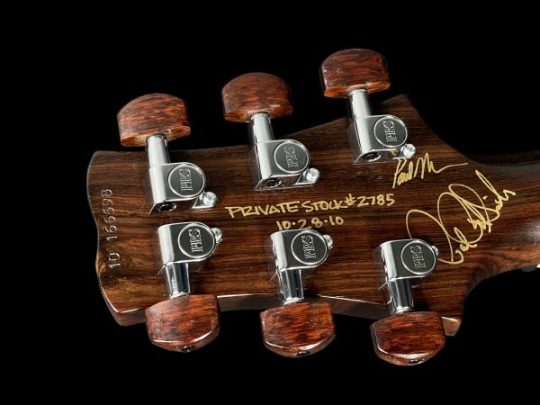

2010 Paul Reed Smith PRS DC245 Ted McCarty Private Stock ~ Copperhead (via G-Brat's Guitars)
11 notes
·
View notes
Photo
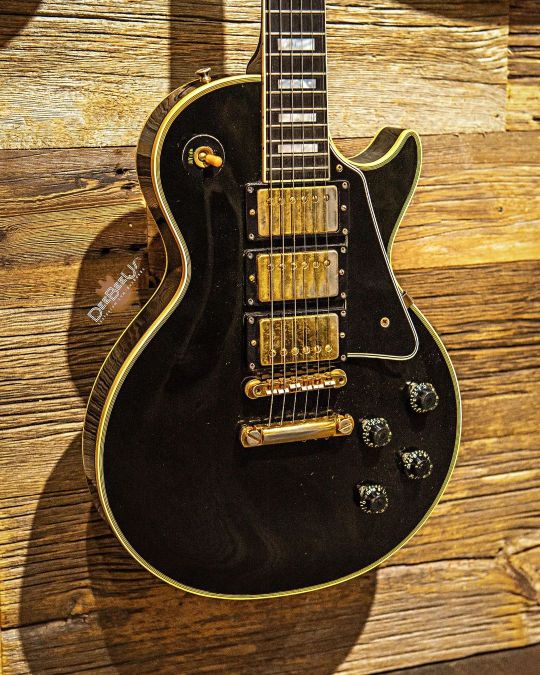
And then there was that time I spotted a rare and endangered triple #PAF 1958 #LesPaul Custom in the wild... 😳 This ain't no reissue...it's the real deal from Ted McCarty's golden age. Everyday is #Gibson day with a guitar like this one! #gibsonlespaul #lespaulcustom #notareissue #pafpickups #gibsunday #gibmonday #blackbeauty #guitar #guitars #guitarra #chitarra #guitarre #electricguitar #vintageguitars #vintagegibson #gibsonguitars #tone #guitargear #guitarsdaily #guitarsofinstagram #geartalk #vintagegear #gibsonsofinstagram #guitarphotography https://www.instagram.com/p/CfCVYhTrX1Y/?igshid=NGJjMDIxMWI=
#paf#lespaul#gibson#gibsonlespaul#lespaulcustom#notareissue#pafpickups#gibsunday#gibmonday#blackbeauty#guitar#guitars#guitarra#chitarra#guitarre#electricguitar#vintageguitars#vintagegibson#gibsonguitars#tone#guitargear#guitarsdaily#guitarsofinstagram#geartalk#vintagegear#gibsonsofinstagram#guitarphotography
12 notes
·
View notes
Text



01/07/2023 - Happy 65th Birthday to the flying V! Patented on January 7, 1958, by Gibson's Ted McCarty.
#flyingv#gibsonflyingv#givsoncustomshop#electricalguitarcompany#dunableguitars#dunableasteroid#themajornelson#nelsonchristopherala#sonya7r2#sonya9#canvasprint#music#metal#sonyalpha#nyc#nelsonicsoundworks#nelsonicphotomedia#nelsonala
3 notes
·
View notes
Text
Epiphone

There's a funny quirk about Gibson's history as a company.
Their guitars have a legacy that's almost bulletproof, and a story going back to the days where the Civil War was a living memory. But despite that rich history, they've almost always been bumbling idiots as an actual business.
Successes came either by accident or by the vision of a singular force (specifically speaking about guitarist Les Paul and CEO Ted McCarty). They're the second most guilty party for deforesting a huge amount of Brazi's rosewood.
They've either been a bloated mess of a corporate balance sheet, or a penny pinching miser of a company since the 1960's...coasting off the legacy of a bunch of guys who played their dad's guitars or only listen to Led Zeppelin and the Allman Brothers (not that that's a bad thing).
But in the late 1950's, Ted McCarty was still there...they were enjoying the financial successes of the early electric guitar era...and their fiercest rival was in their death throes. A brand that people now associate with Gibson's budget line has a history that's largely been lost.
***
The guitar wars follow the industry's momentum.
Today's industry has bifurcated into extremely cheaply made, yet incredibly widely available, guitars that are designed for fun and for students...that have become so quality that they can be used professionally without any loss in performance...and the higher-end vintage and boutique industry aimed at more discerning musicians, hobbyists and collectors.
It's bifurcated this way because there really aren't any musical trends to follow like in the past. In the 2000's there were vintage revivals, funky models, you'd likely notice the guitar trends if you watched any of these pockets of music. The emo guys all played Fender Jazzmasters and other odd models from the past that were ignored because they wern't cool. The corporate rock guys all played PRS. Country guys all played Telecasters. It was extremely predictable.
Same in the 90's with the 7-string numetal stuff...or coasting on the lo-fi Nirvana/grunge wave...I could point at the Brian Setzer revolution and correlate Gretsch's catalog pretty closely. This isn't even touching on the shred metal 80's...or the Les Paul dominated 70's.
Point being...in the 1930's, 40's, 50's and early 60's...it was the archtop wars. The kings of the guitar world played John D'Angelico's guitars...this was not a lucrative industry. The serfs played Kays, Harmonys, Sears, etc...this was a more lucrative one. The battle for the princes was faught between Stromberg, Epiphone and Gibson...this is where the money was.
***


Pre-Gibson Arms Race
Gibson archtops were classy, powerful and smooth...which was awesome and everything, but you gotta remember this was the era before amplifiers, where an archtop was designed to cut through a big band acoustically.
Interestingly enough, Gibson archtops from this era...in my opinion...sound better solo than they do in a group. That's only because, in a group, Epiphones and Strombergs were really, really fucking good. Gibsons were great too, don't ge me wrong, but if you were asking me my ideal for this? I wouldn't go Super 400...I'd go with the 19" behemoth Stromgerg Master 400.
It was all about size and projection, two things cloesly tied. The biggest Gibson was the Super 400, which I talked about last week from an electric perspective. That metaphor above about a classy Gibson?
Epiphones and Strombergs were ready for street fights and both had models with more muscle than even the brawny Super 400. These are nasty, rough, honking guitars that bark like a pissed off pit bull. I've had the pleasure of playing a Master 400 and it was preposterously loud.
But as we know, arms races aren't only decided by the arms themselves...and Gibson's massive corporate size gave them the ultimate advantage. Epiphone's been a staple as a budget line since the early 80's at least...when was the last time you ever heard of Stromberg guitars?
***

Quality Quirkiness
Epiphones of this era were always quirky...and that's not really a compliment either. Almost every electric model I've played from this era, I've gone "man, I really wish it didn't have that" because some quirk...either the way you select pickups, or the pickups themselves (typically very low output and noisy), or the knobs, or hardware...it's just annoying shit that gets in the way.
Because look past all that weird looking stuff. Look at that spruce top. That is a spruce top that guitar nerds like me spend hours drooling over, you just rarely see shit that fucking perfect anymore.

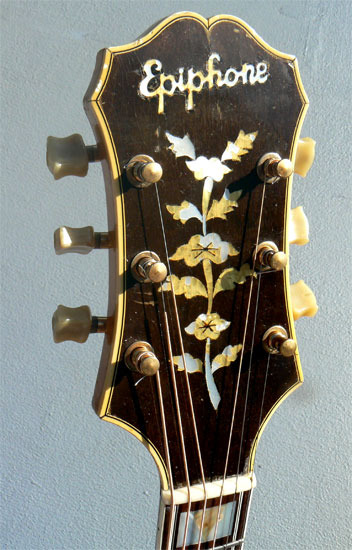
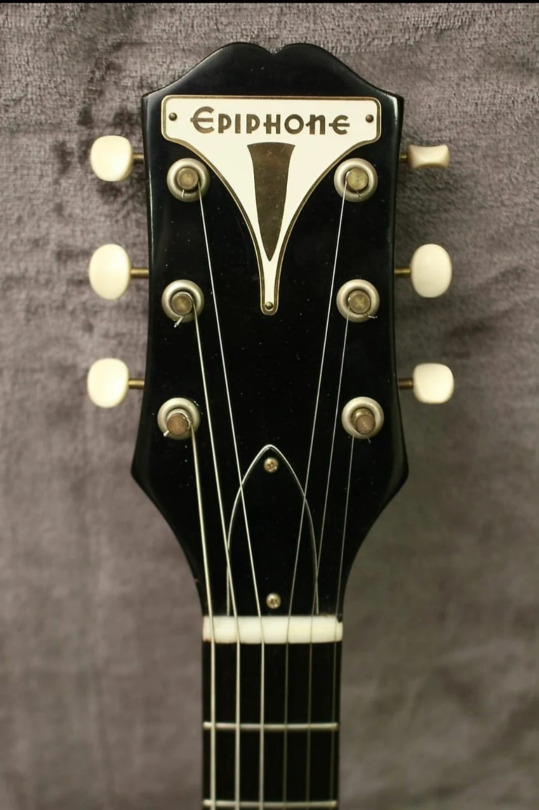


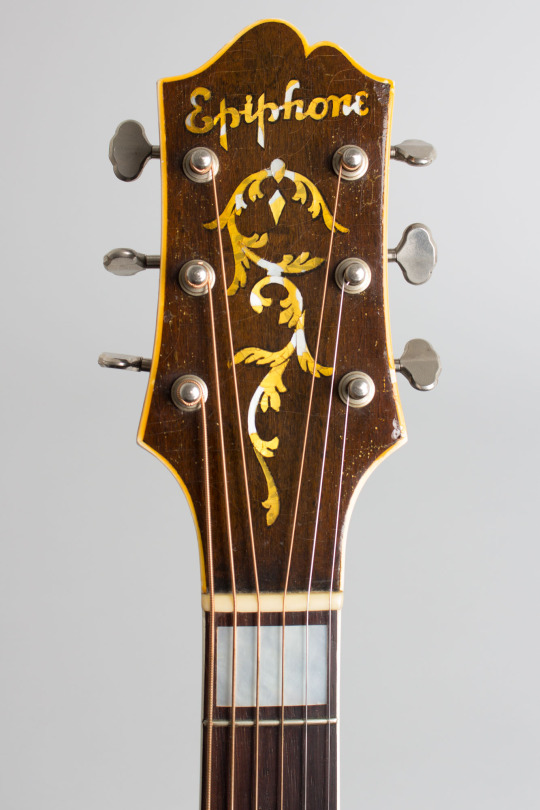
Look at that goddamned craftsmanship and attention to detail on those headstocks. Jesus fucking Christ that is so cool, each one so unique, so stylish, so well executed...you simply just don't see this shit anymore because it's so costly and time consuming. But my goodness, it's impressive.
The woods Epiphone used back then are so quality, and the workmanship so refined, it shouldn't be much of a surprise to know that they hold their value quite well, even relative to Gibson's from that era.
Gibson wasn't exactly throwing plain Janes out there, but they were uniform, consistent and they didn't have nearly the volume of styles and shapes that Epiphone threw out there. And that's probably a huge reason why Gibson didn't go broke making these things.
***
youtube
Early Years with GIbson
Above is a video showing off Robben Ford's 1965 Epiphone Riviera.
Unfortunately these guitars...and their fully hollow, P-90 pickup equipped cousins, the Casino...share a close relationship with John Lennon, who's a documented no-playing assclown.
The Riviera is nothing more than a Gibson ES-335 with mini-humbuckers (sound sweeter and less aggressive than full humbuckers because of the smaller magnet) and different makeup. The Casino was nothing more than a Gibson ES-330.
Epiphones were now being made in Gibson's factory in Kalamazoo, Michigan by the same guys, using the same equipment and parts. At this point in the game, the only differences are subtle, cosmetic and the name on the headstock.
Ok, here's the point where I'm going to wrap it up...
I talked about how quirky and and how many different models and how much different shit Epiphone did during this era...and you know what? It's made Googling this shit a real pain in the ass. There's a Triumph, a Triumph Deluxe, a Triumph De Luxe, a Trumph Masterbilt, a Triumph Masterbuilt...and like 3 of the 5 aren't stupid misspellings, they're their own model.
And then you're flooded with the bullshit...
"Vintage epiphone archtop 1950's" shouldn't have a 2015 Epiphone Zakk Wylde Les Paul as one of the first fucking image results. I mean, what the fuck? I expect more out of Google, I really do.
Look at all these pics so far. Old, aged, yellowed, fuddy duddy...and you're telling me THIS falls within those search parameters? This is what you're telling me Google? I didn't even say "guitar" in my search, I specified archtop...but I did say "vintage" and "1950's" and what about this fucking thing qualifies? God fucking damnit I should've asked Jeeves.

***
Conclusion
You know, I gotta be honest, I just didn't get into 1917. Like it was visually impressive and everything, but here's the thing...30 tracking shots don't make up for the fact that the only thing, literally the only fucking thing, you have to root for is a completely empty vessel.
ItS sO tHe AuDiEnCe CaN pUt ThEmSeLvEs In HiS sHoEs
No it's not, fuck that. Why should I be invested in this charisma-less, personality-less, walking definition of replacement player when...oh look, there's 30 other fucking other anonymous, character-less British dudes right behind him that could do the exact same thing. It's like if they made the Mortal Kombat movie and made the main star this guy...

Anyways, Epiphones these days...shit, for my lifetime...have been average to above average budget guitars that you can beat the hell out of until you can afford a Gibson. They're really good today tho...like good enough to get you to ask yourself "why am I paying this much for a Gibson?"
My two years of college prep and my first three years of college were on an Epiphone Joe Pass Emperor.
The abuse this thing took was tremendous. Before I retired it, the bridge was destroyed, it was on its third nut, there were three different brands of tuners on it, the bridge pickup was just a hole, there were dents and cracks all over it, and the neck was completely bowed from me having 15 gauge strings on it.
And it was totally fine.
Modern Epiphone...you can say the same thing...it's fine. Totally fine. Just kinda sucks though that the guitars from their heyday are forgotten memory because the name's now so synonymous with a budget line.
0 notes
Text



01/07/2023 - Happy 65th Birthday to the flying V! Patented on January 7, 1958, by Gibson's Ted McCarty.
#flyingv#gibsonflyingv#givsoncustomshop#electricalguitarcompany#dunableguitars#themajornelson#nelsonchristopherala#sonya7r2#sonya9#canvasprint#rocknroll#dunableasteroid#nelsonicphotomedia#nelsonala
0 notes
Text
Epiphone model number search

EPIPHONE MODEL NUMBER SEARCH SERIAL NUMBERS
EPIPHONE MODEL NUMBER SEARCH SERIAL NUMBER
While that’s all super interesting, many people wonder where Epiphone guitars are currently made.Īlmost all Epiphone guitars are made in the Epiphone Qingdao factory in Qingdao, China, a major city in the Shandong province. He moved to New York in 1903, taking his business with him, and when his son Epaminondas took over the business a few years later, he rechristened the fledgling company “Epiphone”, combining his own nickname “Epi” with the Greek word for “voice”, “phone”. A musical instrument builder by the name of Anastasios Stathopoulos opened a business in 1873 in Smyrna, deep in the Ottoman Empire. The Epiphone company’s origins lay in the late 19th century. Although today, Epiphone is probably best known as the affordable foreign-manufactured Gibson, the brand has a long and storied history of its own.
EPIPHONE MODEL NUMBER SEARCH SERIAL NUMBERS
Last 4 digits: Production sequence number.Įpiphone hasn't released particulars of the letter ID codes at this point.Ī reference to Epiphone serial numbers is available at in PDF (Adobe Acrobat) format.Fittingly for a company first founded in the Ottoman Empire, Epiphone guitars are made in factories all over the world.
EPIPHONE MODEL NUMBER SEARCH SERIAL NUMBER
Korean-made Epiphones have a letter (manufacturer's ID code) and a 7 or 8-digit serial number as follows:įirst digit (7) or first 2 digits (8): Year of manufacture. Gibson-built Epiphones followed the Gibson serial numbering scheme. Original Epiphones had a number of different serial numbering schemes, depending on the year. The exception to this is the Japanese-era guitars the serial numbering doesn't seem to have followed any sequential pattern from year to year, which makes it *very* difficult to date them accurately. Most Epiphones can be dated fairly accurately by their serial numbers. With some exceptions, Epiphones are made in Korea to this day. In 1983, around the time that Gibson was bought by a group headed by Henry Juszkiewicz (now President of Gibson USA), Epiphone production was contracted to Korean companies, most notably Samick (of which Epiphone/Gibson owns a significant percentage). The Japanese Epis are good guitars, but they suffered both the 'Made in Japan' and 'Norlin' stigmas they've always been under-rated as a result. Epiphone production was contracted to companies in Japan in order to cut costs. In 1969, Norlin Industries bought the Chicago Musical Instrument company (which owned Gibson at the time), which heralded the 'Dreaded Norlin Era' at Gibson, in which the quality declined greatly. This worked well for both Gibson and Epiphone, because it allowed music dealers who couldn't get an official Gibson franchise (which were *very* strictly enforced in those days) to get an Epiphone (which had become a quasi-Gibson) franchise instead. That led to Gibson building Epiphones in the Gibson factory the first few years (1958-61), Gibson used up all the old parts, and in the early 60's, used Gibson parts. Gibson President Ted McCarty (who recently passed away R.I.P., Ted) negotiated a deal to buy out Epiphone's upright bass business, but when the equipment was moved to Gibson's Kalamazoo factory, McCarty found out that *all* of Epiphone's equipment, tooling, and parts inventory had been included. Conn company (best known for band and orchestral instruments), and was all but out of business. In 1957, Epiphone was tenuously clinging to existence the company had been bought out by the C.G. That was the era of the legendary archtops like the Regent, Broadway, Deluxe, etc. The original Epiphone factory was in New York, when the company was owned and operated by the Stathopoulo family. Charlie, if this has been posted before please delete it or move it.

0 notes
Text

Tonight’s Broadcast offers The Penthouse audience A “Brand New” All DUETS Show. Tune in 9PM(ET) to www.thepenthouse.fm
Some of the singers that will be part of the mix:
Rosemary Clooney (Official) & Frank Sinatra, Ann Hampton Callaway & Liz Callaway, Jimmy Webb & Glen Campbell (Official), Ann Osmond & Dennis Yerry, Jazz Cabaret Duo, STEVE LAWRENCE & EYDIE GORME, Eric Comstock + Barbara Fasano, MICHAEL HAYDEN & SALLY MURPHY, John Kander & Fred Ebb, Chita Rivera & MARY McCARTY, LAUREN BECALL & MARILYN COOPER, Liza Minnelli & Billy Stritch, Ella Fitzgerald & Louis Armstrong, LOUISE CARLYLE & BOB SHAVER, Margaret Whiting & TED THURSTON, Jessica Molaskey & John Pizzarelli, REBECCA LUKER & RYAN SILVERMAN, LOUIS PRIMA & KEELY SMITH, Jane Scheckter & Tony DeSare, Linda Purl & Tom Wopat, Julie Wilson & WILLIAM ROY, Judy Garland & ETHEL MERMAN & More!
And some of the Songs:
“Let’s Take A Walk Around The Block”, “Peach Tree Street”, “These Boots Are Made For Walking”, “By The Time I Get To Phoenix”, “You’ll Never Get Away From Me”, “We Got Us”, “As Long As I Live”, “I Want To Be Happy / Sometimes I’m Happy”, “I Didn’t Know About You”, “Oh Me, Oh My / Cheerful Little Earful”, “That Smile”, “Love Is Here To Stay”, “It Still Isn’t Over”, “Happiness”, “Love Story”, “If I Loved You”, “Money, Money, Money”, ”Class”, “The Grass Is Greener”, Here’s To Us / Little Me”, “I’ve Got You Under My Skin”, “Friendship Medley” & More!
0 notes
Text
youtube
2017? Was it THAT long ago?
Let's "time travel" shall we?
LOVED this guitar!
One if my FAVORITE videos I made at Elderly Instruments.......
#electricguitar#guitarist#guitars#guitar#blues guitar#gibson#kalamazoo#parsons street#ted mccarty#les paul#p90pickups#custom#1956#pat zelenka show#pat zelenka
1 note
·
View note
Text
Gibson vs PRS: Battle Over Theodore Trademark and Silver Sky Saga
Gibson vs. PRS - The two US guitar giants are arguing trademarks over the Gibson Theodore and the Silver Sky Nebula
In the world of iconic guitars, a new legal drama is unfolding. The legacy of Ted McCarty, a renowned guitar designer, is at the heart of a heated dispute between two giants in the industry: Gibson and PRS.
The Spark of the Dispute: Gibson’s Theodore Guitar
Gibson, known for its legendary guitars, recently unveiled the ‘Theodore’ guitar, a design based on an undiscovered concept by Ted McCarty…

View On WordPress
#Battle Over Theodore Trademark#Gibson#Gibson vs. PRS:#Joe Bonamassa#John Mayer#legal battle#McCarty#Nebula#Paul Reed Smith#PRS#Silver Sky#Silver Sky Nebula#Silverburst#Ted McCarty#Theodore#trademark#video#YouTube
0 notes
Text
Submission--family tree
i was bored so i decided to make you a tree of the cullens and their human families
carlisle cullen
mary cullen (1624-1640)
abraham cullen (1600-1683)
* carlisle cullen (1640)
esme cullen
mamie patricia platt (neé howell 1869-1947)
george hayes platt (1870-1944)
* esme anne platt (1895-)
edward cullen
edward anthony masen sr. (1867-1918)
elizabeth louise masen (nee McCormick 1875-1918)
* edward anthony masen (1901-)
rosalie hale
warren fitzpatrick hale sr. (1893-1936)
lilliane alta hale (neé vanderbilt 1896-1984)
* rosalie lillian hale (1915-)
* warren fitzpatrick hale jr. (1921-2009)
* edward vanderbilt hale (1925-)
emmett cullen
roy milhous mccarty (1884-1956)
shirley rebecca mccarty (neé emmett 1886-1966)
* roy milhous mccarty jr.(1902-1975)
* joseph arnold mccarty (1904-2000)
* samuel houston mccarty (1905-1998)
* jebediah arthur mccarty (1907-2004)
* thomas charles mccarty (1909-1995)
* lester william mccarty (1912-1941)
* emmett atticus mccarty (1915-)
* herbert andrew mccarty (1917-2011)
* gatlin theodore mccarty (1919-2001)
* robert beckett mccarty (1921-2016)
* jonah clayton mccarty (1924-)
* lucille dorothy mccarty (1927-)
mary alice brandon
marshall lawrence brandon (1869-1943)
barbara jeanne brandon (neé tatum (1874-1919)
theresa carolyn brandon (neé sigurdson (1891-1979) remarried
* mary alice brandon (1901)
* sarah cynthia brandon (1910-2006)
jasper whitlock
hamilton johnson whitlock (1819-1857)
virginia frances whitlock (neé brown 1820-1900)
* abigail olive whitlock (1839-1887)
* mary ann whitlock (1842-1923)
* jasper benjamin whitlock (1844-)
* henrietta lou whitlock (1847-1938)
Very cool! Thanks so much for sharing it with us! It’s so frustrating that SM didn’t give the parents of the Cullens names, even in the guide! And I share your headcanons of Abraham Cullen and Edward Hale. It’s part of why Rosalie’s relationship with Edward is so complicated, because one of her beloved little brothers was also named Edward, but I imagine they called him Teddy or something. One time she slipped up and called Edward Ted/Teddy and it was weird and sad for everyone.
142 notes
·
View notes
Text
You Oughta “Get Carter”
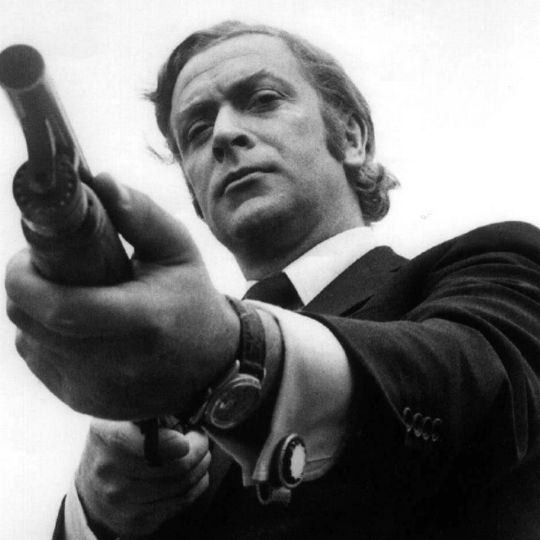
Another old Night Flight piece, tied to a Turner Classic Movies airing, about a movie I never tire of watching. (Unfortunately, the Krays film “Legend” turned out to be not so good.)
**********
The English gangster movie has proven an enduring genre to this day. The 1971 picture that jumpstarted the long-lived cycle, Get Carter, Mike Hodges’ bracing, brutal tale of a mobster’s revenge, screens late Thursday on TCM as part of a day-long tribute to Michael Caine, who stars as the film’s titular anti-hero.
We won’t have to wait long for the next high-profile Brit-mob saga: October will see the premiere of Brian Helgeland’s Legend, a new feature starring Tom Hardy (Mad Max: Fury Road, The Dark Knight Rises, Locke) in a tour de force dual role as Ronnie and Reggie Kray, the legendarily murderous identical twin gangleaders who terrorized London in the ‘60s. The violent exploits of the Krays mesmerized Fleet Street’s journalists and the British populace until the brothers and most of the top members of their “firm” were arrested in 1968.
The siblings both died in prison after receiving life sentences. They’ve been the subjects of several English TV documentaries and a 1990 feature starring Martin and Gary Kemp of Spandau Ballet. However, the Krays and their seamy milieu may have had their greatest impact in fictional form, via the durable figure of Jack Carter, the creation of a shy, alcoholic graphic artist, animator, and fiction writer named Ted Lewis, the man now recognized by many as “the father of British noir.”
Born in 1940 in a Manchester suburb, Lewis was raised in the small town of Barton-upon-Humber in the dank English midlands. A sickly child, he became engrossed with art, the movies, and writing. The product of an English art school in nearby Hull, he wrote his first, unsuccessful novel, a semi-autobiographical piece of “kitchen sink” realism called All the Way Home and All the Night Through, in 1965.
He soon moved sideways into movie animation, serving as clean-up supervisor on George Dunning’s Beatles feature Yellow Submarine (1968). However, now married with a couple of children, he decided to return to writing with an eye to crafting a commercial hit, and in 1970 he published a startling, ultra-hardboiled novel titled Jack’s Return Home.
British fiction had never produced anything quite like the book’s protagonist Jack Carter. He is the enforcer for a pair of London gangsters, Gerald and Les Fletcher, who bear more than a passing resemblance to the Krays. At the outset of the book, recounted in the first person, Carter travels by train to an unnamed city in the British midlands (modeled after the city of Scunthorpe near Lewis’ hometown) to bury his brother Frank, who has died in an alleged drunk driving accident.
Carter instantly susses that his brother was murdered, and he sets about sorting out a hierarchy of low-end midlands criminals (all of whom he knew in his early days as a budding hoodlum) responsible for the crime, investigating the act with a gun in his hand and a heart filled with hate. He’s no Sam Spade or Phillip Marlowe bound by a moral code – in fact, he once bedded Frank’s wife, and is now sleeping with his boss Gerald’s spouse. He’s a sociopathic career criminal and professional killer – a “villain,” in the English term -- who will use any means at his disposal to secure his revenge.
Carter’s pursuit of rough justice for his brother, and for a despoiled niece, attracts the attention of the Fletchers, whose business relationships with the Northern mob are being disrupted by their lieutenant’s campaign of vengeance. As Carter leaves behind a trail of corpses and homes in on the last of his quarry, the hunter has become the hunted, and Jack’s Return Home climaxes with scenes of bloodletting worthy of a Jacobean tragedy, or of Grand Guignol.
Before its publication, Lewis’ grimy, violent book attracted the attention of Michael Klinger, who had produced Roman Polanski’s stunning ‘60s features Repulsion and Cul-de-Sac. Klinger acquired film rights to the novel before its publication in 1970, and sent a galley copy to Mike Hodges, then a U.K. TV director with no feature credits.
Hodges, who immediately signed on as director and screenwriter of Klinger’s feature – which was retitled Get Carter -- was not only drawn to the taut, fierce action, but also by the opportunity to peel away the veneer of propriety that still lingered in British society and culture. As he noted in his 2000 commentary for the U.S. DVD release of the film, “You cannot deny that [in England], like anywhere else, corruption is endemic.”
Casting was key to the potential box office prospects of the feature, and Klinger and Hodges’ masterstroke was securing Michael Caine to play Jack Carter. By 1970, Caine had become an international star, portraying spy novelist Len Deighton’s agent Harry Palmer in three pictures and garnering raves as the eponymous philanderer in Alfie.
Caine had himself known some hard cases in his London neighborhood; in his own DVD commentary, he says that his dead-eyed, terrifyingly reserved Carter was “an amalgam of people I grew up with – I’d known them all my life.” Hodges notes of Caine’s Carter, “There’s a ruthlessness about him, and I would have been foolish not to use it to the advantage of the film.”
Playing what he knew, Caine gave the performance of a lifetime – a study in steely cool, punctuated by sudden outbursts of unfettered fury. The actor summarizes his character on the DVD: “Here was a dastardly man coming as the savior of a lady’s honor. It’s the knight saving the damsel in distress, except this knight is not a very noble or gallant one. It’s the villain as hero.”
The supporting players were cast with equal skill. Ian Hendry, who was originally considered for the role of Carter, ultimately portrayed the hit man’s principal nemesis and target Eric Paice. Caine and Hendry’s first faceoff in the film, an economical conversation at a local racetrack, seethes with unfeigned tension and unease – Caine was wary of Hendry, whose deep alcoholism made the production a difficult one, while Hendry was jealous of the leading man’s greater success.
For Northern mob kingpin Cyril Kinnear, Hodges recruited John Osborne, then best known in Great Britain as the writer of the hugely successfully 1956 play Look Back in Anger, Laurence Olivier’s screen and stage triumph The Entertainer, and Tony Richardson’s period comedy Tom Jones, for which he won an Oscar for best adapted screenplay. Osborne, a skilled actor before he found fame as a writer, brings subdued, purring menace to the part.
Though her part was far smaller than those of such other supporting actresses as Geraldine Moffat, Rosemarie Dunham, and Dorothy White, Brit sex bomb Britt Ekland received third billing as Anna, Gerald Fletcher’s wife and Carter’s mistress. Her marquee prominence is somewhat justified by an eye-popping sequence in which she engages in a few minutes of steamy phone sex with Caine.
Some small roles were populated by real British villains. George Sewell, who plays the Fletchers’ minion Con McCarty, was a familiar of the Krays’ older brother Charlie, and introduced the elder mobster to Carry On comedy series actress Barbara Windsor, who subsequently married another member of the Kray firm. John Bindon, who appears briefly as the younger Fletcher sibling, was a hood and racketeer who later stood trial for murder; a notorious womanizer, he romanced Princess Margaret, whose clandestine relationship with Bindon later became a key plot turn in the 2008 Jason Strathan gangster vehicle The Bank Job.
Verisimilitude was everything for Hodges, who shot nearly all of the film on grimly realistic locations in Newcastle, the down-at-the-heel coal-mining town on England’s northeastern coast. The director vibrantly employs interiors of the city’s seedy pubs, rooming houses, nightclubs and betting parlors. In one inspired bit of local color, he uses an appearance by a local girl’s marching band, the Pelaw Hussars, to drolly enliven a scene in which a nude, shotgun-toting Carter backs down the Fletchers’ gunmen.
The film’s relentless action was perfectly framed by director of photography Wolfgang Suchitzky, whose experience as a cameraman for documentarian Paul Rotha is put to excellent use. Some sequences are masterfully shot with available light; the movie’s most brutal murder plays out at night by a car’s headlights. The breathtakingly staged final showdown between Carter and Paice is shot under lowering skies against the grey backdrop of a North Sea coal slag dump.
Tough, uncompromising, and utterly unprecedented in English cinema, Get Carter was a hit in the U.K. It fared poorly in the U.S., where its distributor Metro-Goldwyn-Mayer dumped it on the market as the lower half of a double bill with the Frank Sinatra Western spoof Dirty Dingus Magee. In his DVD commentary, Caine notes that it was only after Ted Turner acquired MGM’s catalog and broadcast the film on his cable networks that the movie developed a cult audience in the States.
Get Carter has received two American remakes. The first, George Armitage’s oft-risible 1972 blaxploitation adaptation Hit Man, starred Bernie Casey as Carter’s African-American counterpart Tyrone Tackett. It is notable for a spectacularly undraped appearance by Pam Grier, whose character meets a hilarious demise that is somewhat spoiled by the picture’s amusing trailer. (Casey and Keenan Ivory Wayans later lampooned the film in the 1988 blaxploitation parody I’m Gonna Git You Sucka.)
Hodges’ film was drearily Americanized and relocated to Seattle in Stephen Kay’s like-titled 2000 Sylvester Stallone vehicle. It’s a sluggish, misbegotten venture, about which the less that is said the better. Michael Caine’s presence in the cast as villain Cliff Brumby (played in the original by Brian Mosley) only serves to remind viewers that they are watching a vastly inferior rendering of a classic.
Ted Lewis wrote seven more novels after Jack’s Return Home, and returned to Jack Carter for two prequels. The first of them, Jack Carter’s Law (1970), an almost equally intense installment in which Carter ferrets out a “grass” – an informer – in the Fletchers’ organization, is a deep passage through the London underworld of the ‘60s, full of warring gangsters and venal, dishonest coppers.
The final episode in the trilogy, Jack Carter and the Mafia Pigeon (1977), was a sad swan song for British noir’s most memorable bad man. In it, Carter travels to the Mediterranean island of Majorca on a Fletchers-funded “holiday,” only to discover that he has actually been dispatched to guard a jittery American mobster hiding out at the gang’s villa. It’s a flabby, obvious, and needlessly discursive book; Lewis’ exhaustion is apparent in his desperate re-use of a plot point central to the action of the first Carter novel.
Curiously, the locale and setup of Mafia Pigeon appear to be derived from Pulp, the 1975 film that reunited director Hodges and actor Caine. In it, the actor plays a writer of sleazy paperback thrillers who travels to the Mediterranean isle of Malta to pen the memoirs of Preston Gilbert (Mickey Rooney), a Hollywood actor with gangland connections. Hilarity and mayhem ensue.
All of Lewis’ characters consume enough alcohol to put down an elephant, and Lewis himself succumbed to alcoholism in 1982, at the age of 42. Virtually unemployable, he had moved back home to Barton-upon-Humber, where lived with his parents.
He went out with a bang, however: In 1980, he published his final and finest book, the truly explosive mob thriller GBH (the British abbreviation for “grievous bodily harm”). The novel focuses on the last days of vice lord George Fowler, a sadist in the grand Krays manner, whose empire is being toppled by internal treachery. Using a unique time-shifting structure that darts back and forth between “the smoke” (London) and “the sea” (Fowler’s oceanside hideout), it reaches a finale of infernal, hallucinatory intensity.
After Lewis’ death, his work fell into obscurity, and his novels were unavailable in America for decades. Happily, Soho Press reissued the Carter trilogy in paperback in 2014 and republished GBH in hardback earlier this year. Now U.S. readers have the opportunity to read the books that influenced an entire school of English noir writers, including such Lewis disciples and venerators as Derek Raymond, David Peace, and Jake Arnott.
Echoes of GBH can be heard in The Long Good Friday, another esteemed English gangster film starring Bob Hoskins as the arrogant and impetuous chief of a collapsing London firm. Released the same year as Lewis’ last novel, the John Mackenzie-directed feature is only one of a succession of outstanding movies – The Limey, The Hit, Layer Cake, Sexy Beast, and Lock, Stock and Two Smoking Barrels among them – that owe a debt to Get Carter, the daddy of them all.
5 notes
·
View notes
Text
California Proposition Assessment
1. “English Proficiency. Multilingual Education. Initiative Statute” or proposition 58 from 2016
2. Prop 58 aimed to “[preserve the] requirement that public schools ensure students become proficient in English”. Because prop 58 passed, students with limited English proficiency have the ability to learn English through their school district which is beneficial for their future and all in the community.
3. There is no notable fiscal effect on school districts nor state government.
4. The election results of Prop 58, of 2016, did surprise me as 73.52% of persons voted yes on prop 58
5.
Proposition 58 Sponsors:
-Sen. Ricardo Lara (D-33)
-Sen. Loni Hancock (D-9)
-Sen. Bill Monning (D-17)
-Sen. Martin Block (D-39)
-Asm. Nancy Skinner (D-15)
-Asm. Lorena Gonzalez (D-80)
-Gov. Jerry Brown (D)[6]
-Lt. Gov. Gavin Newsom (D)
-State Superintendent Tom Torlakson
-Secretary of State Alex Padilla (D)
-State Controller Betty Yee (D)
-Insurance Commissioner Dave Jones (D)
-U.S. Rep. Judy Chu (D-27)
U.S. Rep. Ted Lieu (D-39)
U.S. Rep. Alan Lowenthal (D-47)
U.S. Rep. Adam Schiff (D-28)
Sen. Kevin de Leon (D-24)
Sen. Ben Allen (D-26)
Sen. Jim Beall (D-15)
Sen. Hannah-Beth Jackson (D-19)
Sen. Isadore Hall (D-35)
Sen. Ed Hernandez (D-22)
Sen. Jerry Hill (D-13)
Sen. Mark Leno (D-11)
Sen. Connie Leyva (D-20)
Sen. Carol Liu (D-25)
Sen. Mike McGuire (D-2)
Sen. Tony Mendoza (D-32)
Sen. Holly Mitchell (D-30)
Sen. Richard Pan (D-6)
Sen. Fran Pavley (D-27)
Sen. Richard Roth (D-31)
Sen. Bob Wieckowski (D-10)
Sen. Lois Wolk (D-3)
Asm. Anthony Rendon (D-63)
Asm. Luis Alejo (D-30)
Asm. Rob Bonta (D-18)
Asm. Ian Calderon (D-57)
Asm. Nora Campos (D-27)
Asm. David Chiu (D-17)
Asm. Kansen Chu (D-25)
Asm. Cristina Garcia (D-58)
Asm. Eduardo Garcia (D-56)
Asm. Jimmy Gomez (D-51)
Asm. Reginald Jones-Sawyer (D-59)
Asm. Kevin McCarty (D-7)
Asm. Miguel Santiago (D-53)
Asm. Susan Talamantes Eggman (D-13)
Asm. Tony Thurmond (D-15)
Asm. Das Williams (D-37)
Mayor Ed Lee, San Francisco
Mayor Bao Nguyen, Garden Grove
Mayor Robert Garcia, Long Beach
[Parties]
-California Democratic Party[7]
-Green Party of California[8]
-California Peace and Freedom Party[9]
-Harvey Milk LGBT Democratic Club[10]
-Santa Monica Democratic Club[11]
Interest group endorsements:
N/A
-Financial Backers:
-California Teachers Association PAC~$1,722,048.00
-SEIU Local 2015 Issues PAC~$104,833.18
-California Federation of Teachers COPE Prop/ Ballot Committee~$100,000.00
-Association of California School Administrators Issues PAC~$100,000.00
-SEIU California State Council~$100,000.00
I was unfortunately unable to find/locate the endorsements although the financial backets are quite understandable as they consist of teachers' organizations/committees or are mostly education related. By understanding the financial backers it is clear what this props aimed demographic is.
6.
Arguments for Prop 58
“PROPOSITION 58 ENSURES ALL STUDENTS CAN ACHIEVE ENGLISH PROFICIENCY AS SOON AS POSSIBLE.”
“Too many California students are being left behind and not given the opportunity to learn English with the most effective teaching methods possible. This is because of an outdated nearly 20-year-old law, Proposition 227, which restricts the instructional methods school districts can use to teach English.Proposition 58 revises Proposition 227 to remove these restrictions so schools are able to use the most up-to-date teaching methods possible to help our students learn.”
Requires local school districts to identify in their annual K-12 Local Control and Accountability Plans the instructional methods they will offer to help ensure all students become proficient in English as rapidly as possible.
Requires schools to offer a structured English immersion program to English learners. But schools also can adopt other language instruction methods based on research and stakeholder input.
School districts must seek input from educators, parents and the community.
“PROPOSITION 58 ALSO EXPANDS OPPORTUNITIES FOR ENGLISH SPEAKERS TO LEARN A SECOND LANGUAGE.”
Proposition 58 removes barriers hurting students by discouraging schools from expanding multilingual education. Proposition 58 encourages school districts to provide instruction programs so native English speakers can become proficient in a second language:
School districts must include in their annual K-12 Local Control and Accountability Plans programs giving English-speaking students the opportunity to achieve proficiency in a second language.
District choices of non-English languages must reflect input from parents, the community and the linguistic and financial resources of schools.
Research shows that students participating in programs taught in more than one language attain higher levels of academic achievement.
PROPOSITION 58 RESTORES LOCAL CONTROL TO OUR SCHOOLS.
Proposition 58 allows local school districts to choose the most up-to-date language instruction methods to improve student outcomes free from legal restrictions imposed on them by a decades-old law.
PROPOSITION 58 PROVIDES A BETTER FUTURE FOR OUR CHILDREN AND OUR STATE.
The world economy is changing rapidly. Today, technology allows even the smallest businesses to have a global reach. Students proficient in English and a second language will be more employable, start out earning higher wages, and make California's workforce better prepared to compete for jobs in the global economy.
PROPOSITION 58 HAS BROAD-BASED SUPPORT FROM LOCAL SCHOOL DISTRICTS, EDUCATORS, PARENTS AND EMPLOYERS.
Giving local schools the tools they need to improve outcomes for students is not a partisan or political issue. Proposition 58 was placed on the ballot by a bipartisan vote of the legislature. Support for Proposition 58's common sense reforms to improve language instruction in our schools is broad-based and includes: Local school boards (the California School Boards Association), Teachers (the California Language Teachers' Association, the California Teachers Association, the California Federation of Teachers), Parents (California State PTA), and Employers (including the San Jose I Silicon Valley and Los Angeles Chambers of Commerce).
Proposition 58's reforms allow schools to adopt the most up-to-date methods of language instruction to improve student outcomes and make better use of taxpayer dollars
Arguments against Prop 58
“THIS BALLOT MEASURE IS A DISHONEST TRICK BY THE SACRAMENTO POLITICIANS”
The official title of Proposition 58 is "English Language Education," But it actually REPEALS the requirement the children be taught English in California public schools. It's all a trick by the Sacramento politicians to fool the voters, who overwhelmingly passed Proposition 227, the "English for the Children" initiative in 1998.
The worst part of Proposition 58 is hidden away in Section 8, which REPEALS all restrictions on the California Legislature to make future changes. This would allow the Legislature to reestablish SPANISH-ALMOST-ONLY instruction in the public schools by a simple majority vote, once again forcing Latino children into those classes against their parents' wishes.
Teaching English in our public schools is overwhelmingly supported by California parents, whether immigrants or non-immigrants, Latinos or Anglos, Asians or Blacks. That's why the politicians are trying to TRICK the voters by using a DECEPTIVE TITLE.
“VOTE NO AND KEEP "ENGLISH FOR THE CHILDREN"---IT WORKS!”
For decades, millions of Latino children were FORCED INTO SPANISH-ALMOST-ONLY CLASSES dishonestly called "bilingual education." It was an educational disaster and never worked. Many Latinos never learned how to read, write, or even speak English properly.
But in 1998, California voters overwhelmingly passed Prop. 227—the "English for the Children" initiative---providing sheltered English immersion to immigrant students and requiring that they be taught English as soon as they started school.
Jaime Escalante of Stand and Deliver fame, one of America's most successful teachers led the Prop. 227 campaign as Honorary Chairman, rescuing California Latinos from the Spanish-only educational ghetto.
It worked! Within four years the test scores of over a million immigrant students in California increased by 30%, 50%, or even 100%.
All the major newspapers, even the national New York Times, declared the new English immersion system a huge educational success.
The founding president of the California Association of Bilingual Educators announced that he'd been wrong about bilingual education for thirty years and became a leading national advocate for English immersion.
Since "English for the Children" passed, there has been a huge increase in the number of Latinos scoring high enough to gain admission to the prestigious University of California system.
Prop. 227 worked so well in California schools that the whole issue was forgotten by almost everyone except the bilingual education activists. Now they're trying to trick the voters into allowing the RESTORATION OF MANDATORY SPANISH-ALMOST-ONLY CLASSES.
7. I would’ve voted YES on prop 58 as I believe a foundational understanding of English is important and necessary young Americans.
8. I found it interesting that the Libertarian Party of California were opponents of Prop 58.
3 notes
·
View notes
Photo

Just arrived a 1951 Gibson L-7N with floating Ted McCarty pickups! (please click on the link in our profile to learn more and to purchase). Thanks. (at Retrofret Vintage Guitars) https://www.instagram.com/p/B6JbrqhAyFA/?igshid=1p4ujmy1pjmyq
21 notes
·
View notes
Text

The Gibson Les Paul
The result of a collaboration between Gibson Guitars and the late jazz guitarist Les Paul, electric guitars very quickly became a public craze.
In 1902, The Gibson Mandolin guitar company was formed. Gibson’s first electric guitar the ES-150 was produced in 1936, and in 1946 Gibson introduced the P-90 single coil pickup, which was eventually used on the first Les Paul model made in 1952.
The Gibson Les Paul was the result of a design collaboration between Gibson Guitar Corporation and the late jazz guitarist and electronics inventor Les Paul. In 1950, with the introduction of the Fender Telecaster to the musical market, electric guitars became a public craze.
While working in his small Kalamazoo, Michigan workshop on a hot summer afternoon in 1894, Orville Gibson did not comprehend the affect his instruments would have on the music world. Starting with strong convictions about instrument design and quality, Orville created a whole new family of guitars and mandolins and later inspired generations of craftsmen to produce some of the finest instruments the world has ever heard or seen.
A virtuoso classical mandolinist and acoustical engineer, Lloyd Loar joined Gibson in 1919, one year after Orville’s death. Loar’s cultivations of Orville’s original carving concepts brought about the Master Model F-5 mandolin and L-5 guitar, with tuned tops and backs and the first “f” holes ever found on fretted instruments. The F-5 was hastily judged the greatest mandolin ever built, while the L-5, in the hands of players like Eddie Lang, became the first guitar to take a serious role in the orchestra scene. It quickly replaced the tenor banjo as a rhythm instrument and became the basis for Gibson’s dominance and superiority in the new field of arch top guitars.
The 1920’s saw another period of incredible innovations, including elevated fingerboards, bridges with height adjustment, and Thaddeus McHugh’s adjustable truss rod, patented in 1921. Simple and direct in operation, the truss rod balanced the tension of the strings on the neck and kept the neck in perfect alignment. The 1920’s also saw Gibson develop banjo concepts like the modern tone ring and resonator, which revolutionized the tenor banjo of its day and laid the foundation for Earl Scruggs and Bluegrass music 20 years later.
The 1937 Gibson catalogue featured a new electric guitar, the ES-150. This “Electric Spanish” guitar blended the new technology of magnetic pickups with arch-top design in an instrument designed to be amplified. When a young man from Oklahoma named Charlie Christian plugged in with Benny Goodman, he turned the guitar into a lead instrument. Music would never be the same and Christian’s forceful lead guitar lines invented a whole new musical style that’s been duplicated for over 50 years.
Les Paul had been developing the concept of the solid body guitar since the 1930’s. In 1941, he split an arch-top Epiphone in half lengthwise and bolted both sides to a 4″ x 4″ solid block. This two pickup monster (Les called it “The Log”) was not a pretty sight, but it established Les’ idea that solid body instruments had a unique sound and musical future.
Les had presented his ideas to Gibson in 1945 or 1946, but demand for traditional Gibson’s that the company didn’t see the need. According to Les, “They politely ushered me out the door. They called it the broom-stick with a pickup on it.” However, several years later, Gibson executives recognized the significance and future of Les Paul’s solid body design.
Ted McCarty found Les and Gibson’s Les Paul guitar made its debut in 1952. For the first time, two woods – maple for the top and mahogany for the back – were combined on a solid instrument for a musical purpose, balancing the bright attack of maple with the warmth and richness of mahogany. The tune-o-matic bridge appeared on the Les Paul in 1954, and the humbuckers followed in 1957. When the LP was offered with a cherry sunburst top in 1958, one of the greatest electric guitar designs ever was firmly established.
By the late 1950s, the Les Paul was considered “staid and old-fashioned”, no longer competitive with the Stratocaster, and by 1961 Gibson stopped producing the Les Paul in favour of the SG. The mid-1960s, however, brought a resurgence of interest in the Les Paul, a development credited to one man and one album: Eric Clapton, using a Les Paul plugged into a Marshall Bluesbreaker as recorded on Blues Breakers with Eric Clapton (the “Beano” album, 1966), set the standard for tone for a new generation of guitar players in blues and rock and roll.
2 notes
·
View notes